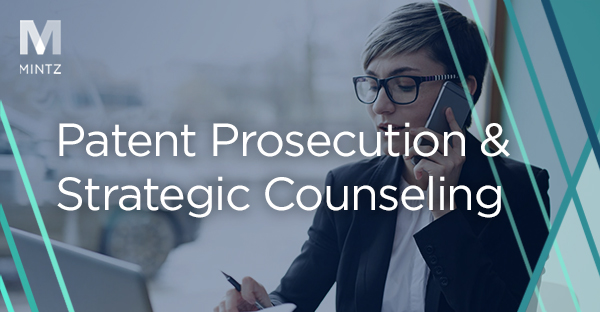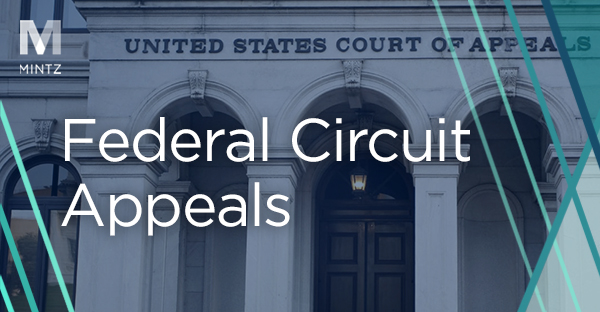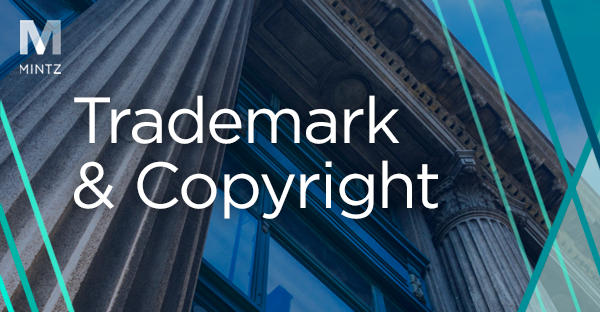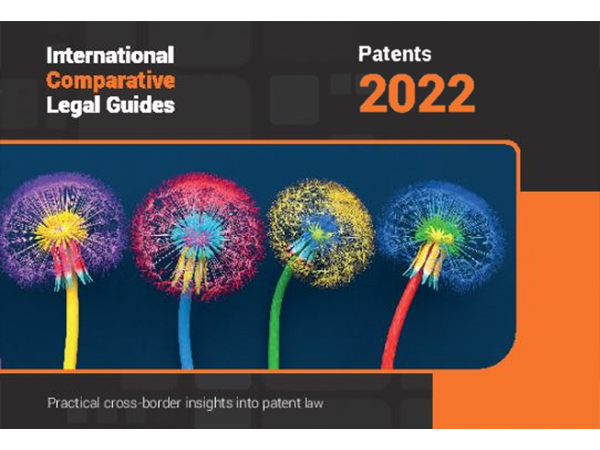
Intellectual Property
Viewpoints
Filter by:
EXCLUSIVE RIGHTS: Intellectual Property — Claim Construction Perspectives — from a Litigator and a Prosecutor
June 4, 2021 | Podcast | By Andrew DeVoogd
A PhD-holding patent prosecutor and a seasoned ITC and district court litigator talk claim construction. Can they possibly find common ground?
Read more
Failing to Adequately Support a Means-Plus-Function Claim Term Renders a Claim Invalid
June 3, 2021 | Blog | By Pedro Suarez, Joshua Berk
Claim language is important. Particularly when dealing with software systems, claims may be held invalid as being indefinite when the claim language is characterized as “means-plus-function” under pre-AIA 35 U.S.C. §112 ¶ 6 (now AIA 35 U.S.C. §112(f)).
Read more
Patent Owner Tip #8 for Surviving an Instituted IPR: Additional Discovery is Possible, but Should be Carefully Planned
May 27, 2021 | Blog | By Michael Newman, Nana Liu
Discovery procedures in inter partes review (“IPR”) proceedings, governed by 37 CFR § 42.51, are more limited in scope and timing compared to cases in district court.
Read more
How NFTs and Blockchain Secure Digital Sports Collectibles
May 24, 2021 | Blog | By Andrew D. Skale
Today, there are new opportunities to own a bit of sports history. It is now possible to even own a digital collectible of your favorite athlete making a play during a game. NFTs (non-fungible tokens) are being used to provide digital provenance that affords unique ownership of sports most memorable moments.
Read more
Patent Owner Tip #7 for Surviving an Instituted IPR: Work with Your Expert to Make the Declaration Navigable and Well Supported
May 20, 2021 | Blog | By Peter Cuomo
Expert declarations are an essential component of any patent owner’s effort to survive an instituted inter partes review (“IPR”). The Board relies heavily on expert testimony in order to evaluate and understand the technology at issue from the point of view of a person of ordinary skill in the art (“POSA”).
Read more
EXCLUSIVE RIGHTS: Intellectual Property — Understanding the SCOTUS Fair Use Decision in Google v. Oracle
May 20, 2021 | Podcast | By Michael Graif
Does Google’s Android API infringe Oracle’s copyright in its Java API? That’s the question the Supreme Court was asked to deal with in Google v. Oracle recently.
Read more
ITC’s New Pilot Program to Speed Investigations Merely Another Bite of the 100-Day Pilot Program Apple?
May 18, 2021 | Blog | By Daniel Weinger
Over the last decade, patent litigation has exploded at the International Trade Commission (“ITC”), which has caused the ITC to seek out ways to increase efficiency. Several years ago, the ITC introduced an early 100-Day pilot program to dispose of dispositive issues early on in investigations. While now a mainstay, the 100-Day pilot program is rarely utilized.
Read more
EXCLUSIVE RIGHTS: Intellectual Property — US Signals Approval of IP Waiver for COVID-19 Vaccines
May 13, 2021 | Podcast | By Daniel Weinger
In this episode of our Exclusive Rights podcast series, Mintz IP attorneys Daniel Weinger and Todd B. Buck, PhD, discuss the recent decision by the Biden Administration to signal US approval of a proposal to waive intellectual property rights related to COVID-19 vaccines currently under review at the World Trade Organization (WTO).
Read more
Patent Owner Tip #6 for Surviving an Instituted IPR: Using Objective Sources & Evidence to Support the Expert Declaration
May 13, 2021 | Blog | By William Meunier , Courtney Herndon
As we have previously discussed, expert testimony is a critical aspect of the Patent Owner’s case-in-chief of an inter partes review (“IPR”) proceeding. In addition to retaining the right expert witness and maximizing that expert’s testimony in the expert declaration, it is imperative that expert testimony is supported by objective, contemporaneous documentary evidence.
Read more
Patent Owner Tip #5 for Surviving An Instituted IPR: The Right Expert Can Save Your Patent
May 6, 2021 | Blog | By Daniel Weinger, Monique Winters Macek
The right expert can be the critical piece that saves the validity of your patent. Finding the right expert for a patent owner requires careful selection and due diligence. We previously detailed how your expert’s testimony can make or break your Patent Owner’s Response (“POR”).
Read more
EXCLUSIVE RIGHTS: Intellectual Property — Basics of ITC Litigation
May 6, 2021 | Podcast | By Daniel Weinger, Andrew DeVoogd
Intellectual property rights protect your innovations and competitive position in the market.
Read more
Speeding Examination of Related U.S. and Japanese Patent Applications
May 3, 2021 | Blog | By Christina Sperry
It is not uncommon for applicants to file related patent applications in the United States and in Japan. When the applications claim priority to a common patent application, or one of the applications claims priority to the other, the applications’ family relationship can be used advantageously to speed prosecution in one or both jurisdictions. Multiple programs exist to expedite prosecution at the U.S. Patent and Trademark Office (USPTO) and the Japan Patent Office (JPO).
Read more
Patent Owner Tip #4 For Surviving An Instituted IPR: Take the Time to Use Your Expert as an Expert
April 29, 2021 | Blog | By Brad M Scheller , Nana Liu
The expert declaration provides a unique opportunity for Patent Owners to bolster their case during the discovery period of an inter partes review (“IPR”) proceeding. We previously detailed how to effectively use an expert declaration in the Patent Owner’s Preliminary Response (“POPR”). Now we turn to maximizing your expert’s testimony for the Patent Owner’s Response (“POR”).
Read more
Patent Owner Tip #3 for Surviving An Instituted IPR: How Patent Owner Experts Go from Zero to Hero
April 22, 2021 | Blog | By Michael Newman, Courtney Herndon
Drafting the expert declaration is another critical task for Patent Owners during the inter partes review (“IPR”) discovery period. As noted in our previous post, IPR expert witnesses provide declarations as affirmative testimony in lieu of live testimony before the Board at the hearing.
Read more
The Federal Circuit Provides New Guidance for Patent Licensees Wishing to Challenge the Licensed Patent’s Validity
April 21, 2021 | Blog | By Brad M Scheller , Peter Cuomo, Monique Winters Macek, Mark Hammond
The Federal Circuit in Apple Inc. v. Qualcomm Incorporated handed down a decision on April 7, 2021 that provides guidance on the determination of standing for patent licensees who wish to contest the validity of a patent or patents in a licensed portfolio.
Read more
PTAB Reinforces Uneven Evidentiary Playing Field in IPRs
April 16, 2021 | Blog | By Daniel Weinger, Nana Liu
The U.S. Patent and Trademark Office’s Patent Trial and Appeal Board (PTAB) recently grappled with the admission into evidence of expert deposition testimony that was presumably harmful to the petitioner in an inter partes review (IPR), and barred the testimony from coming into evidence.
Read more
Patent Owner Tip #2 for Surviving An Instituted IPR: Don’t Swing for the Fences in IPR Depositions
April 15, 2021 | Blog | By Peter Cuomo
As discussed in our previous post, one of the most critical tasks for Patent Owners during the Inter Partes Reviews (“IPR”) discovery period is deposing the Petitioner’s expert. Since IPR depositions are treated differently than fact-gathering depositions in district court litigation, a Patent Owner should approach the IPR deposition with different goals.
Read more
Patent Owner Tip #1 For Surviving An Instituted IPR: Approach IPR Depositions Like A Cross-Examination
April 8, 2021 | Blog | By William Meunier , Sean Casey
As a Patent Owner in an instituted Inter Partes Reviews (“IPR”), one of the first and most critical tasks before you is deposing the Petitioner’s witnesses, including its experts. But approaching an IPR deposition like a typical litigation deposition could be a big mistake.
Read more
United States Supreme Court Rules for Google in a Landmark Fair Use Decision
April 6, 2021 | Blog | By Michael Graif , Matthew Hurley, Geoffrey Friedman
On April 5, 2021, the United States Supreme Court issued a significant fair use decision, holding six to two that Google’s copying of 11,500 lines of code from Oracle’s Java SE API in Google’s Android platform was a fair and transformative use.
Read more
District of Delaware Recites Policy Rationale for Dismissing Willful and Indirect Infringement Claims for Failure to Plead Pre-Suit Knowledge of Infringement
April 5, 2021 | Blog | By Adam Samansky, Peter Cuomo, Joe Rutkowski
On March 24, 2021, U.S. District Judge Colm F. Connolly of the District of Delaware, granted a defendant’s motion to dismiss claims for contributory and induced infringement and enhanced damages under 35 U.S.C. § 284 because the complaint alleged knowledge of the asserted patents solely based on averments in prior original and amended complaints in the same lawsuit.
Read more
Explore Other Viewpoints:
- Data Centers & Digital Infrastructure
- AI: The Washington Report
- Antitrust
- Appellate
- Arbitration, Mediation & Alternate Dispute Resolution
- Artificial Intelligence
- Awards
- Bankruptcy & Restructuring
- California Land Use
- Cannabis
- Class Action
- Complex Commercial Litigation
- Construction
- Consumer Product Safety
- Corporate Governance (ESG)
- Cross-Border Asset Recovery
- DEI Legal Developments
- Debt Financing
- Direct Investing (M&A)
- Diversity
- EB-5 Financing
- Education & Nonprofits
- Employment
- EnforceMintz
- Environmental (ESG)
- Environmental Enforcement Defense
- Environmental Law
- Environmental, Social, and Corporate Governance (ESG)
- FDA Regulatory
- False Claims Act
- Federal Circuit Appeals
- Financial Institution Litigation
- Government Law
- Growth Equity
- Health Care
- Health Care Compliance, Fraud and Abuse, & Regulatory Counseling
- Health Care Enforcement & Investigations
- Health Care Transactions
- Health Information Privacy & Security
- IP Due Diligence
- IPRs & Other Post Grant Proceedings
- Immigration
- Impacts of a New US Administration
- Insolvency & Creditor Rights Litigation
- Institutional Investor Class Action Recovery
- Insurance & Financial Services
- Insurance Consulting & Risk Management
- Insurance and Reinsurance Problem-Solving & Dispute Resolution
- Intellectual Property
- Investment Funds
- Israel
- Licensing & Technology Transactions
- Life Sciences
- Litigation & Investigations
- M&A Litigation
- ML Strategies
- Medicare, Medicaid and Commercial Coverage & Reimbursement
- Mergers & Acquisitions
- Patent Litigation
- Patent Prosecution & Strategic Counseling
- Pharmacy Benefits and PBM Contracting
- Portfolio Companies
- Privacy & Cybersecurity
- Private Client
- Private Equity
- Pro Bono
- Probate & Fiduciary Litigation
- Products Liability & Complex Tort
- Projects & Infrastructure
- Public Finance
- Real Estate Litigation
- Real Estate Transactions
- Real Estate, Construction & Infrastructure
- Retail & Consumer Products
- Securities & Capital Markets
- Securities Litigation
- Social (ESG)
- Special Purpose Acquisition Company (SPACs)
- Sports & Entertainment
- State Attorneys General
- Strategic IP Monetization & Licensing
- Sustainable Energy & Infrastructure
- Tax
- Technology
- Technology, Communications & Media
- Technology, Communications & Media Litigation
- Trade Secrets
- Trademark & Copyright
- Trademark Litigation
- Unified Patent Court (UPC)
- Value-Based Care
- Venture Capital & Emerging Companies
- White Collar Defense & Government Investigations
- Women's Health and Technology










